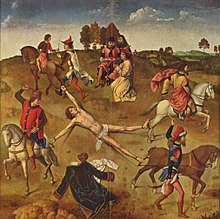Dierick Bouts

Dierick Bouts (* 1410-1420 in Haarlem ; † May 6, 1475 in Leuven ), also Dirk or Dieric , earlier erroneously called Stuerbout , was a Dutch painter. He is the father of Dierick Bouts the Younger and Aelbert Bouts , who also achieved fame as painters. In addition to his church pictures, he was valued for his portraits and was considered one of the leading painters of his time.
Life
Dierick Bout's life is barely documented. Much of the data up to the 1450s can only be determined by comparing styles of pictures and painters. Bouts was probably trained in his hometown of Haarlem and then perhaps came into contact with Petrus Christ . Both show peculiarities of painting from the northern Netherlands with a special interest in the representation of a continuous pictorial space and the landscape. The familiarity with the works of Jan van Eyck and Aelbert van Ouwater and Rogier van der Weyden can also be seen in Bouts' pictures .
Around 1445 Bouts moved to Löwen and a little later married the rich patrician daughter Catharina van der Brugghen from Löwen. There were four children from this marriage. The two sons Dierick Bouts the Younger and Aelbert Bouts became respected painters.
Bouts in Leuven is only documented from 1457. He was appointed town painter in 1465. One of the best-known and most detailed documents is the contract for the making of the Last Supper for the Brotherhood of the Holy Sacrament of 1464.
According to documents, Bouts was a very wealthy citizen. In 1467 he was identified as an important representative of the city. After the death of his wife, shortly before his death in 1475, he married a second time.
Major works
- Altar of Mary (around 1445; Madrid , Prado )
- Passion altar (around 1455; Granada , Museo de la Capilla Real)
- Crucifixion altar (around 1450–60; Brussels , Musées Royaux des Beaux-Arts ; Malibu , J. Paul Getty Museum ; London , National Gallery ; Pasadena , Norton Simon Museum )
- Portrait of a Man (1462; London, National Gallery)
- Ecce Agnus Dei (around 1462–64; Munich , Alte Pinakothek )
- Pearl of Brabant (1460s; assignment not certain ; Munich, Alte Pinakothek)
- Mary and Child (around 1465; London, National Gallery)
- Triptych with the torture of St. Erasmus (1450–60; Leuven, Sint-Pieterskerk , Museum voor Kerkelijke Kunst)
- Last Supper Altar (1464 (Treaty) - 1467; Lions, Sint-Pieterskerk , Museum voor Kerkelijke Kunst)
- The Road to Paradise (around 1468; Lille , Musée Municipale)
- Paradise and Hell (around 1470; Paris , Louvre )
- A Lamentation of Christ (1455–1460 Paris , Louvre )
- Images of Justice (unfinished; 1473 and 1475; Brussels, Musées Royaux des Beaux-Arts)
effect
Comparing styles brought Carl Georg Heise to the conviction that the Westphalian painter Hinrik Funhof learned in Bouts' workshop. The panels of the high altar of St. John's Church in Lüneburg (1482–1484) from Funhof are among the main works of Lower Saxony painting of the second half of the 15th century and show the stylistic influence of Bouts. For the assignment of Funhof as an employee in Bouts' workshop, Heise also mentioned the first documentary mention of Funhof in 1475, the year Bouts died.
literature
- Oskar Eisenmann: Bouts, Dierick . In: Allgemeine Deutsche Biographie (ADB). Volume 3, Duncker & Humblot, Leipzig 1876, pp. 216-218.
- Catheline Périer-D'Ieteren: Dieric Bouts. The complete works . Mercatorfonds, Antwerp 2005, ISBN 90-6153-611-1 (also a French edition).
- Bert Cardon et al. (Ed.): Bouts studies. Proceedings of the international colloquium (Leuven, November 26-28, 1998) . Louvain, Peeters 2001.
- Maurits Smeyers (ed.): Dirk Bouts (approx. 1410–1475), een Vlaams primitief te Leuven . Leuven, Peeters 1998.
- Flemish Masters: Jan van Eyck, Rogier van der Weyden, Hans Memling, Dirk de Vos. DuMont, Cologne, ISBN 3-8321-7201-7 . Pp. 143-156.
- Wolfgang Schöne: Dieric Bouts and his school . Berlin and Leipzig 1938.
- Max Jakob Friedländer (edited by Nicole Veronee-Verhaegen): Early Netherlandish Painting, III: Dieric Bouts and Joos van Gent . New York, Praeger 1968.
Individual evidence
- ↑ Catheline Périer-D'Ieteren: Dieric Bouts. The complete works. Mercator Fund, Antwerp 2005.
- ^ Dörte Zbikowski: For example: Hinrik Funhof .. In: The art of the Middle Ages in Hamburg. Essays on cultural history. Monument Preservation Foundation. Hamburg undated , ISBN 3-933374-49-9 . Pp. 212-218.
Web links
- Literature by and about Dierick Bouts in the catalog of the German National Library
- Works by Dierick Bouts at Zeno.org .
| personal data | |
|---|---|
| SURNAME | Bouts, Dierick |
| ALTERNATIVE NAMES | Bouts, Dieric; Bouts, Dirk; Bouts, Thierry; Bouts, Theodoricus; Bouts, Dieric; Harlemius, Theodorus; Stuerbout |
| BRIEF DESCRIPTION | Dutch painter |
| DATE OF BIRTH | between 1410 and 1420 |
| PLACE OF BIRTH | Haarlem |
| DATE OF DEATH | May 6, 1475 |
| Place of death | Leuven , Belgium |


